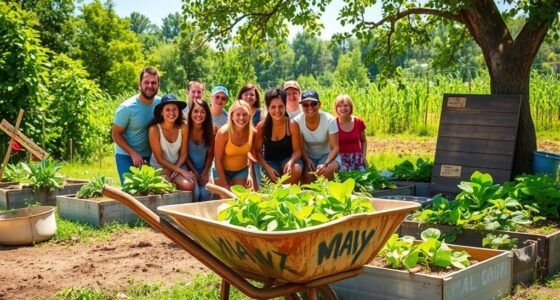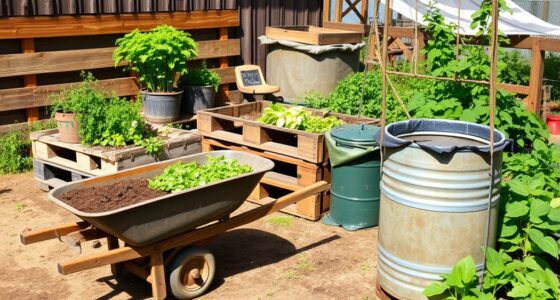Land terracing's all about transforming sloped land into flat platforms for farming. It helps you control water runoff, prevent soil erosion, and boost crop productivity. By enhancing soil fertility, terracing supports sustainable agriculture and reduces the risk of landslides. There are various techniques, like contour and bench terracing, tailored for different slopes. If you're keen to improve your farming practices and explore the benefits further, stick around to learn more about terracing's vital role in agriculture.
Key Takeaways
- Land terracing transforms sloped land into flat platforms, enhancing agricultural productivity and preventing soil erosion.
- It incorporates various techniques like contour, bench, and graded terracing to optimize water retention and soil health.
- Terracing reduces water runoff and promotes long-term soil fertility, supporting sustainable farming practices.
- Historical practices, such as the Rice Terraces of the Philippine Cordilleras, highlight terracing's effectiveness in crop production.
- Community involvement and knowledge sharing are essential for successful terracing implementation and adapting to environmental challenges.
Definition and Purpose of Terracing
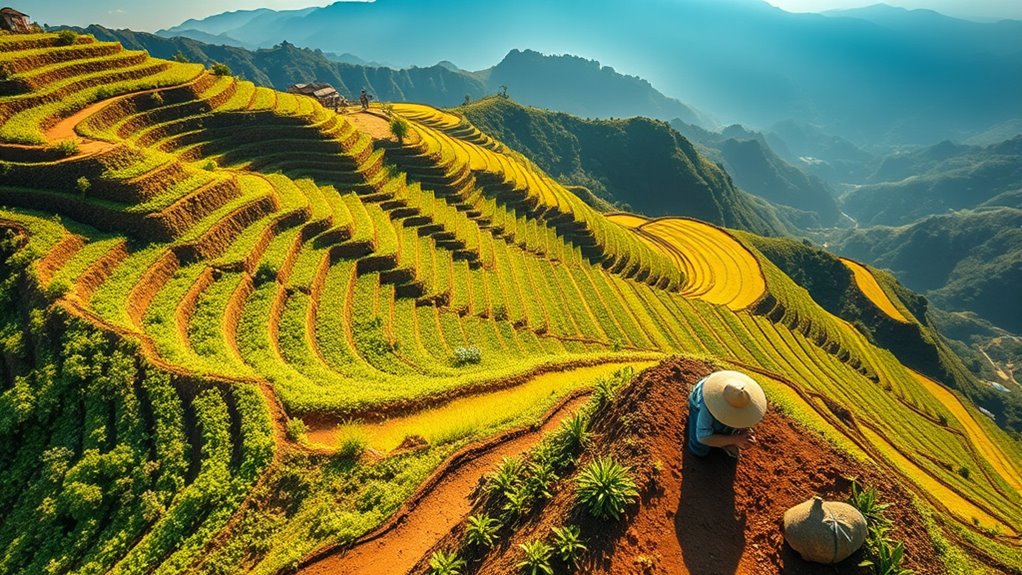
Terracing transforms sloped land into productive agricultural platforms. By creating flat sections on slopes, you can cultivate crops in areas that would otherwise be unsuitable for farming.
The primary purpose of terracing is to control water runoff and prevent soil erosion, which enhances land productivity. It allows you to maintain soil fertility and reduces water pollution, making it essential for sustainable agriculture.
There are various types of terracing, such as graded, level, and bench terracing, each designed to manage water flow differently.
Through effective terracing techniques, you can improve soil conservation, increase water retention, and create diverse habitats, ultimately leading to more productive and resilient farming practices.
Embracing this method can transform your agricultural approach on challenging terrains.
Historical Context of Terracing Practices

Throughout history, various cultures have embraced terracing as a vital agricultural practice, adapting it to their unique landscapes and needs.
Originating in prehistoric times, terracing initially served as fortifications before evolving into a method for intensive agriculture.
You'll find evidence of this technique across Asia, Europe, and the Americas. For instance, the Incas in South America and the Cordilleras tribes in the Philippines were early adopters, showcasing human ingenuity in challenging environments.
The Rice Terraces of the Philippine Cordilleras even earned UNESCO World Heritage status in 1995.
In regions like Southeast Asia and the Mediterranean, terracing has played a crucial role in optimizing crop production, reflecting the cultural significance and ecological balance these methods promote.
Benefits of Terracing for Sustainable Farming
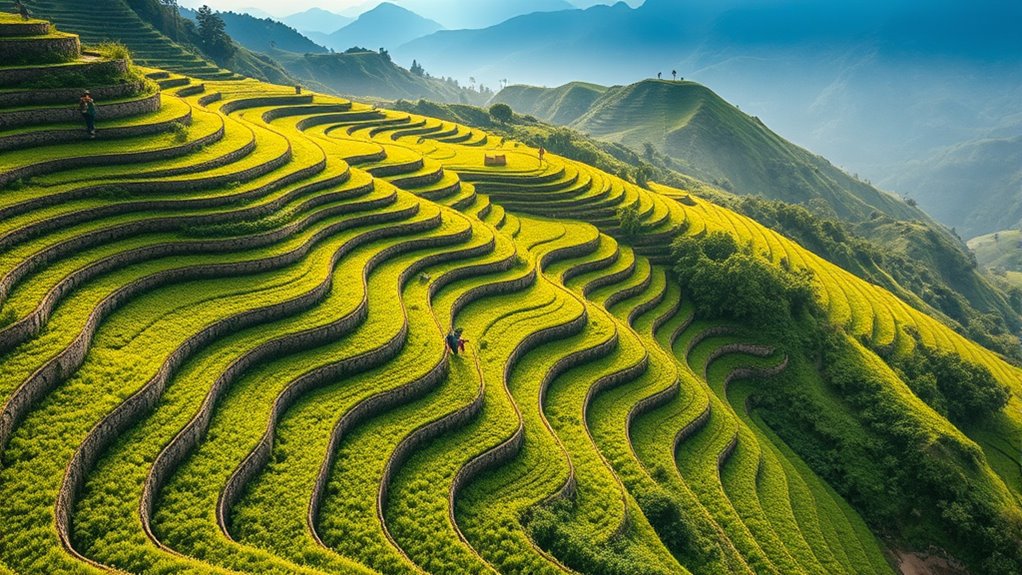
While many farming techniques focus on short-term gains, terracing offers a sustainable solution that benefits both the environment and agricultural productivity.
By preventing soil erosion, terracing slows down water runoff, allowing water to soak into the ground and retaining precious topsoil. This practice enhances long-term soil fertility, which is crucial for maintaining high yields.
Terraces also reduce landslide risks and improve water retention, making them essential for effective rainwater harvesting. Furthermore, they create more arable land, enabling you to cultivate diverse crops and boost production.
Ultimately, terracing supports sustainable agriculture by conserving resources, enhancing ecological resilience, and improving food security, making it a vital practice for farmers looking to thrive in the long run.
Types of Terracing Techniques

Building on the sustainable benefits of terracing, various techniques exist to suit different landscapes and farming needs.
Contour terracing follows slope contours, preventing soil erosion and retaining moisture.
For steep slopes, bench terracing conserves water by trapping it in distinct levels.
If you're working with gentle slopes, stepped terracing effectively controls erosion while keeping moisture in check.
Raised-bed terracing is perfect for crops needing well-drained soil, improving drainage and aeration.
You can choose between graded and level terracing; graded terracing directs water flow with varying slopes, while level terracing ensures even water distribution along contour lines.
Each technique offers unique advantages tailored to your specific farming conditions and goals.
Challenges Associated With Terracing
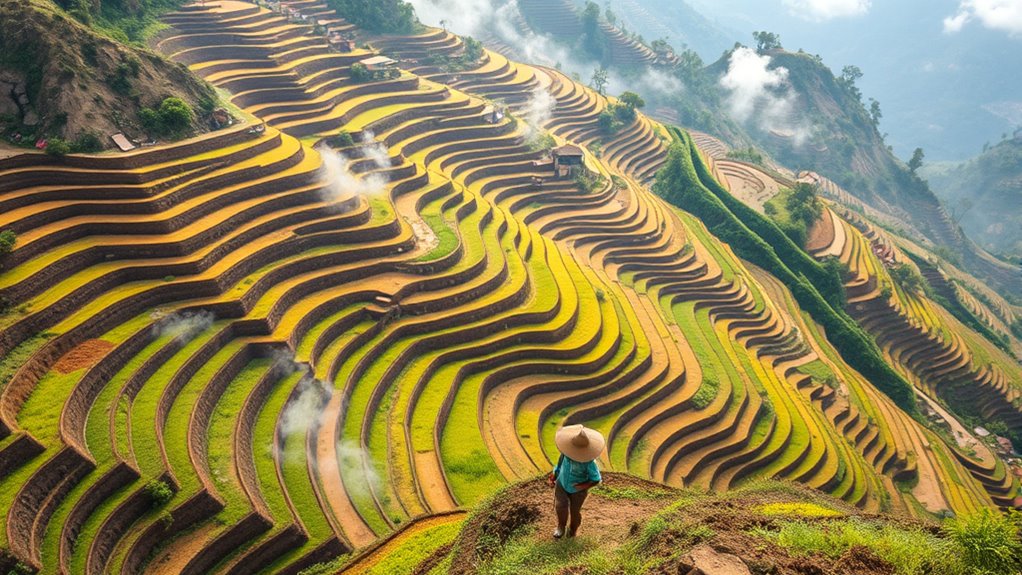
Even though terracing offers numerous benefits for sustainable agriculture, it also presents a range of challenges that can complicate its implementation.
You might find that the limited arable land and small, fragmented holdings in hilly areas make effective management difficult. Steep slopes can narrow terraces, increasing the risk of wall collapse and soil erosion, especially during construction.
Economically, the high initial investment and labor-intensive nature of terracing can strain your resources. Additionally, reliance on external funding may pose risks.
Environmental issues like water saturation and potential landslides complicate matters further.
Socially, labor shortages due to rural migration can hinder your efforts, while community engagement is crucial for successful implementation.
Maintenance Requirements for Terraces
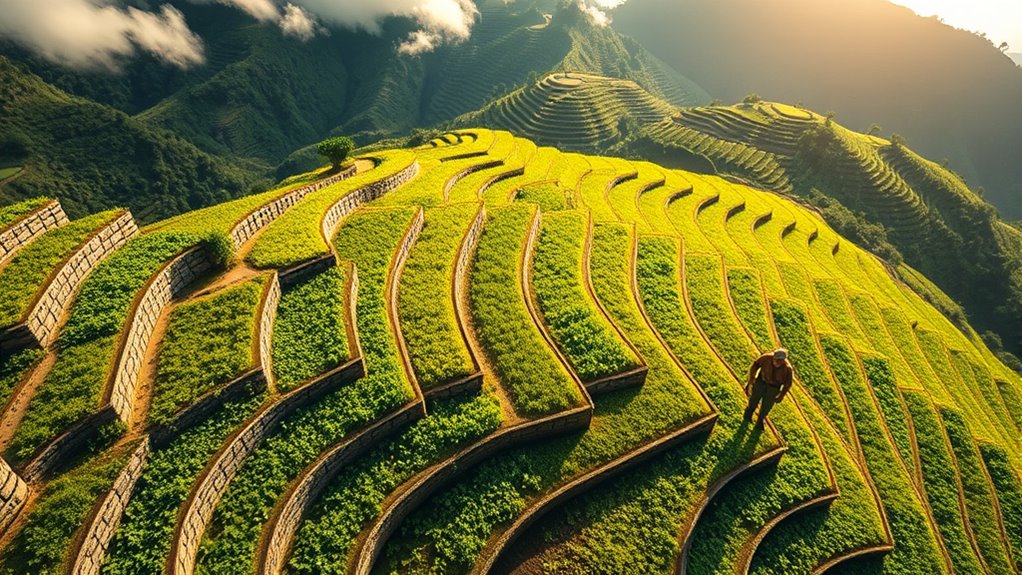
Implementing terraces can present various challenges, but maintaining them is equally important for ensuring their long-term effectiveness.
Regular inspections after significant rainfall are essential to catch erosion and sedimentation issues early. Annual maintenance is crucial, especially for terraces on steep slopes. You can reduce maintenance frequency by implementing conservation practices like no-till farming and cover crops.
Regular inspections after heavy rain are vital to identify erosion early, while annual maintenance is key for steep terraces.
The best time for maintenance is between harvest and snowfall, as this allows for effective evaluation and repair. Use equipment like moldboard and disk plows to reshape terraces and remove sediment. Always maintain ridge height and channel capacity to prevent erosion.
A detailed maintenance plan will help you address issues promptly, ensuring your terraces continue to function effectively for years to come.
Global Applications of Terracing
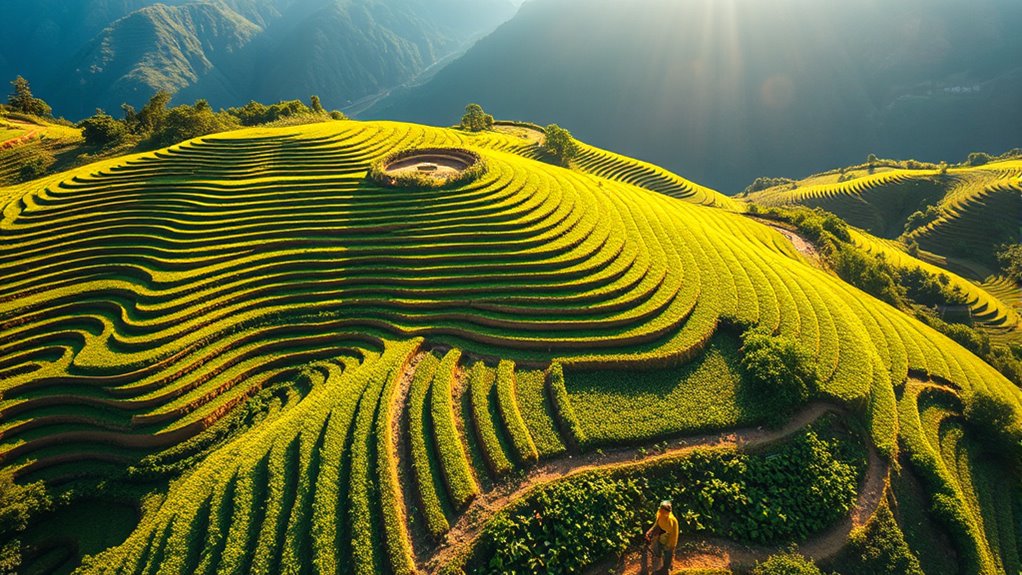
While terracing has ancient origins, its global applications today showcase the adaptability of this agricultural technique across diverse environments.
In East Asia, rice terraces in the Philippines and Indonesia highlight intricate irrigation systems and cultural significance.
South America's Andes use terracing for crops like potatoes, rooted in pre-Inca traditions.
In the Mediterranean, Italy maximizes sun exposure for vineyards and olive groves through terracing.
African regions employ this method for various crops, reflecting local adaptations.
Southeast Asian countries like Vietnam utilize terracing for rice cultivation in mountainous areas.
Each of these examples illustrates how terracing not only boosts agricultural productivity but also supports cultural heritage and sustainable practices worldwide.
Your understanding of these applications can enhance your own farming endeavors.
Terracing and Water Management
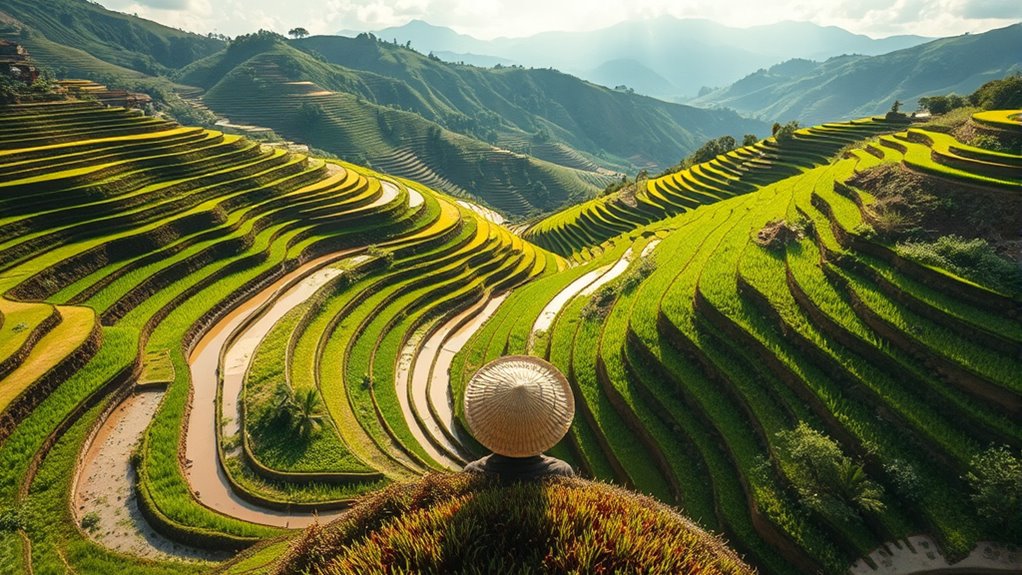
Terracing transforms steep slopes into manageable, flat areas, significantly enhancing water management in agricultural settings.
By slowing down water flow, it allows better infiltration into the soil, which is crucial for crop health. This method conserves water by reducing surface runoff and effectively capturing rainwater, lessening your irrigation needs.
Slowing water flow enhances soil infiltration, conserves water, and captures rain, reducing irrigation needs for healthier crops.
You'll also notice improved soil moisture retention, which benefits your crops. With techniques like contour farming and check dams, terracing minimizes erosion while promoting nutrient cycling.
It's even more efficient than non-terraced plots at controlling erosion, ensuring your land remains fertile.
Future of Terracing in Agriculture

The future of terracing in agriculture looks promising, driven by innovative technologies and sustainable practices.
You'll benefit from modern engineering techniques that enhance efficiency through advanced soil stability analysis. Precision agriculture will help you tailor soil and water management using mapping technologies. Smart irrigation systems can monitor soil moisture in real-time, ensuring optimal crop hydration while minimizing waste.
Drones will enable you to monitor crop health and soil conditions easily, and geotextiles will stabilize slopes, reducing maintenance needs. By embracing terracing, you'll support biodiversity, enhance soil fertility, and increase productivity. Additionally, effective location scouting can optimize the placement of terracing systems to maximize their benefits.
While there are challenges like labor intensity and initial investments, community involvement and knowledge sharing will pave the way for successful terracing practices in a changing climate.
Frequently Asked Questions
How Do I Start Building a Terrace on My Farm?
To start building a terrace on your farm, first assess your land's slope and soil type.
Define the purpose of your terraces, whether for crops or aesthetics.
Mark the contour lines with stakes and strings, then gather sturdy materials like stones or treated lumber for retaining walls.
Begin constructing from the lowest point, ensuring each wall is level.
Compact the soil and manage drainage to prevent erosion.
Regular maintenance will keep your terraces productive.
What Tools Are Needed for Terracing Construction?
To start terracing construction, you'll need specialized tools like terracing plows, which efficiently shape soil.
Equip your tractor with compatible hitches for optimal functionality.
Don't forget bulldozers for heavy earth movement and scrapers to transport soil.
Graders help level the terraces, while conventional moldboard plows can assist in smaller projects.
Regular maintenance of your equipment will ensure longevity and efficiency throughout the terracing process.
Can Terracing Be Done on Small Plots of Land?
Did you know that terracing can increase crop yields by up to 50% on sloped land?
Yes, you can absolutely implement terracing on small plots, especially in hilly areas. It helps manage water efficiently and prevents soil erosion, which is crucial for maintaining fertility.
While it does require significant labor and careful planning, the benefits—like increased productivity and better water conservation—make it a worthwhile investment for small-scale farming.
How Long Does It Take to Construct a Terrace?
Constructing a terrace can take anywhere from a few days to several years, depending on various factors.
If you're using mechanized equipment, like a terracing plow, you can complete large areas quickly. However, if the terrain is steep or complex, or you're relying on manual labor, it could take longer.
Weather conditions and the intricacy of your design also play significant roles in the overall construction timeline.
What Crops Are Best Suited for Terraced Farming?
Imagine a patchwork quilt of crops flourishing on steep hillsides.
You'll find grains like wheat and barley, legumes such as beans, and root vegetables like potatoes thriving in terraced farming.
Fruits and nuts, including apples and almonds, grow well in mild climates.
If you're cultivating in varying conditions, consider herbs and spices too.
Each crop not only adapts but also contributes uniquely to the health of your terraced landscape.
Conclusion
In conclusion, terracing is a vital practice that can transform your farming experience, helping you reap benefits while protecting the land. As the saying goes, "You reap what you sow." By implementing terracing techniques, you're not just enhancing crop yield; you're also promoting sustainability and managing water effectively. Embrace these practices, and you'll contribute to a healthier ecosystem for generations to come. Your efforts today will create a fruitful tomorrow.



